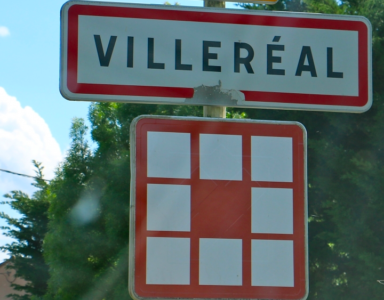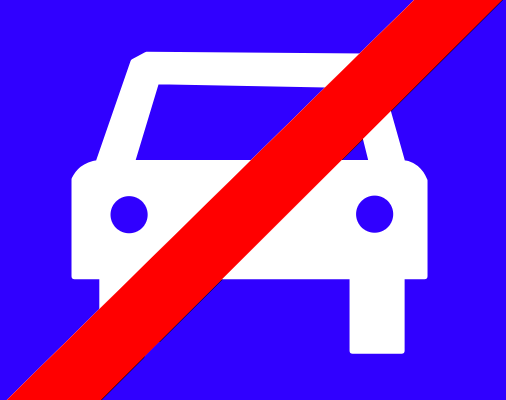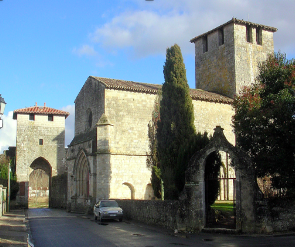What the hell’s a Bastide?
Non-French drivers, especially in southwest France, are often perplexed by a road sign that shows a white square dissected horizontally and vertically by parallel brown lines. It looks like a simplified design for a chocolate bar. The adjacent word, ‘BASTIDE‘ offers little in terms of explanation.

This is only one of several road signs that foreign tourists find confusing or amusing. There’s one with a white car on a blue ground with a red diagonal slash. Are all white cars barred? No, it means “End of fast traffic highway.”
What’s a black vehicle with its bonnet exploding supposed to mean? That’s easy, “No vehicles carrying explosives.”
A yellow square with a black border over what looks like dumbbell weights means the same thing, “Nothing inflammable.”
What a yellow rectangle inside a white one standing on its point means is a bit more of a problem. It indicates a “priority road”. But what this means exactly is too difficult to explain. Maybe other readers can help.
Driving in France – what’s it really like?
However, don’t let any of this put you off driving in France because the roads are invariably good, the signage excellent, and despite much Anglo Saxon carping, most drivers are polite, forgiving, and understanding. Road rage is almost unknown, and in 20 years of driving in France, French motorists have mostly been as nice as pie. When I’ve done something really, really silly in my campervan, making them really annoyed, they’ve occasionally flashed their light at me.
In any case, most French drivers can’t tell you what many road signs are for either. In fact a recent survey on the over 700 signalisations routières in L’Hexagon, half of the French motorists did not understand what the majority of them indicated.
Bastides: do you know the history?
But back to bastides and what they are.
Well, they’re fortified villages dating back to medieval times.
Many of them are in Aquitaine, which, in those days was English.
Yes, this is no typo.
Aquitaine really was English! That’s because soon after Eleanor of Aquitaine’s marriage to her first partner was annulled, her new husband became King Henry II of England, and the area became an English possession. It covered almost all of the southwest of France and would be ruled by the Kings of England for three hundred years.
These bastides consisted of an intersecting grid of streets forming blocks around a central square. This was usually surrounded by arcades where the produce market and political and social events were held. Inhabitants were encouraged to cultivate the land around their village. So the majority of the inhabitants worked in their gardens or shops during the day and retired to their dwellings at night. This industry, in turn, attracted trade in the form of merchants and markets—and they generated taxes.
When Anglo French relations deteriorated, most bastides added defensive walls pierced by a limited number of narrow entrances. This has had the benefit of preserving the bastide from the march of time, and most are well preserved examples of the architecture and town planning of the Middle Ages.
One of the great pleasures of touring in France is unscheduled stops. There’s always something to see and do. A pretty village. A great view. A country market. An amazing old church, monastery, pigeonnier or place. Or a tempting bistro or restaurant. And the bastide road-sign is a signal that you absolutely must stop. Every one is worth a visit. Many of them are on the official list of “The Most Beautiful Villages in France.”
Watch out for those bastide signs
So keep an eye out for that brown sign.
No, it’s not a chocolaterie, it’s a bastide.

And this means that it’s a highly recommended spot for you to stop and spend an hour or two. You’ll get a wonderful and lasting impression of what France was like several centuries ago. Like this exquisite example: Monpazier.
Do you know these signs? Have you been to this region? Share your thoughts and experiences in comments below.
Image credits
1-2. Map of bastides in Aquitaine & Diagram of bastide layout via Wikimedia
3. La Bastide-Clairence via Wikipedia
4. Central market Beaumont de Lomagne via Wikipedia
5. Monpazier via Wikimedia
6-7. Vianne entrance arch x 2 via Wikipedia

















If you’re going to post what you think is helpful information, please make it accurate.
1. A yellow square with a black border over what looks like dumbbell weights means no restricted goods, which is quite a list of items including paint.
2. The yellow lozenge is ‘not too difficult to explain’ If it has a red line through it or the signs are absent on a village sign, vehicles on your right have priority and can pull onto the road you are driving down without warning. You have to imagine a give way sign on your road before every junction on the right. Most towns and villages have priority from the right, and many N roads (and below). It is extremely useful in traffic speed control where selfish drivers cannot drive at or below the posted limit.
It’s also worth mentioning that the speed limit is 50kph once you pass the village sign.